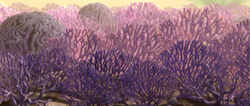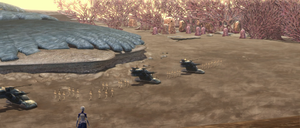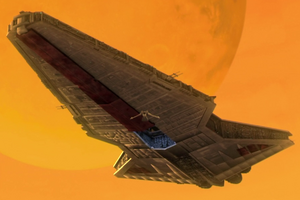| | |
- "Beautiful, this moon, is. Amazing, the universe, is."
- ―Yoda admires Rugosa's beauty
Rugosa, also known as the Coral Moon of Rugosa, was a temperate moon located in the galaxy's Outer Rim Territories close to the planet Toydaria. Rugosa's terrain was once that of vast oceans until they dried up, leaving the moon's surface covered in large forests of coral and rocky cavernous areas. During the Clone Wars, the moon was considered neutral territory, and was chosen as the secret rendezvous point for Jedi Grand Master Yoda to meet with King Katuunko of the Toydarian people to discuss a Toydarian alliance with the Galactic Republic. The meeting was disrupted by the Confederacy of Independent Systems, who hoped to gain the allegiance of the Toydarians themselves, but Katuunko chose to side with the Republic after Yoda defeated a small Separatist force on the moon.
Description[]

Rugosa's coral forests
The remote moon Rugosa[5] was located in the galaxy's Outer Rim Territories[1] close to the planet Toydaria, a world in Hutt Space,[4] which was the homeworld of the Toydarian species.[8] Sometime before the Clone Wars, a large calamity boiled Rugosa's oceans away, leaving the large skeletons of the coral behind.[7]
The moon had a temperate climate,[4] and parts of its surface area were covered by large regions of coral forests, with the corals varying hugely in size and some being large enough to support small starships. Cavernous valley areas also existed on the moon.[5]
History[]
- "General, the Toydarian's beacon is active on the moon, but all our transmissions are being jammed."
- ―A clone reports to Yoda during the Ambush on Rugosa
During the Clone Wars between the Galactic Republic and the Confederacy of Independent Systems, Rugosa was considered a neutral territory. The moon was chosen as the rendezvous point for a secret meeting between King Katuunko, leader of the Toydarian species, and Grand Master Yoda, leader of the Jedi Order. Yoda was to represent the Galactic Republic in the discussion, as the Republic hoped to ally with the Toydarians and build a supply base on their homeworld. In return the Toydarians wanted protection by the Republic during the remainder of the war. Members of the Confederacy of Independent Systems learned of the secret meeting however, and the Sith apprentice Asajj Ventress was sent to disrupt the negotiations and act as a messenger for Count Dooku.[5]

The Separatist Droid Army marches out onto Rugosa.
Katuunko and his guards were the first to reach the moon, soon being joined by Ventress, who played a hologram that allowed Dooku to speak with the King. Meanwhile, Yoda and the Republic forces had arrived in orbit above Rugosa in a Republic frigate, but found their communications jammed by the Separatists. Two Munificent-class star frigates then entered the system, forcing the cruiser to drop off Yoda and three clone troopers in a escape pod and flee. Despite the show of force, Katuunko would not agree to a Separatist alliance. When Yoda contacted the King and revealed he had landed on the moon an agreement was reached that if Yoda could reach the King by sunset then the Republic would have their alliance, but if the Separatist Droid Army could stop the Jedi then the Toydarians would side with the Separatists.[5]
As Yoda and his troops began the journey toward the rendezvous point, a C-9979 landing craft dropped off a battalion of battle droids lead by a droid designated 224, which Ventress ordered to hunt down Yoda. The droids advanced into the coral forests of the moon, and quickly spotted the Republic forces; however, the corals stopped their Armored Assault Tanks from entering into firing range of their foe and so 224 ordered the ground troops to advance alone. Yoda managed to destroy one patrol of B1-series battle droids, and his troops took out another. B2-series super battle droids then pushed back the clones, before Yoda used the Force to defeat them, but a group of Droidekas then forced the entire Republic group to fall back and take shelter in a cave.[5]

A Venator-class Star Destroyer over Rugosa
While Yoda gave a motivational speech to the three troopers, 224 and its tanks advanced into the valley where the Republic forces were hiding. Alone, the Grand Master revealed himself and destroyed the tanks and droid accompanying them, after which the troopers destroyed a group of droideka reinforcements by using a rocket launcher to bring down an outcrop of rock on top of them. Having witnessed the battle from afar, Katuunko turned down Dooku's offer of allegiance, prompting the Count to order Ventress to kill the King. Before the apprentice could strike the Toydarian down however, Yoda arrived and prevented the assassination. Ventress created a small avalanche to distract the Toydarians and Republic forces while she escaped in her solar sailer. Grateful to the Jedi for saving his life, Katuunko offered his sword in allegiance to the Republic, after which the Toydarians, clones, and Yoda were picked up by a Republic gunship deployed from a Venator-class Star Destroyer that had arrived in orbit.[5]
Inhabitants[]
The young of the neebray species lived on Rugosa during the Clone Wars, using the moon as a nursery before embarking on a long migration across space.[5][7]
Behind the scenes[]
Rugosa first appeared in 2008 in "Ambush," the first episode of the first season of the television show Star Wars: The Clone Wars.
Appearances[]
 Star Wars: The Clone Wars — "Ambush" (First appearance)
Star Wars: The Clone Wars — "Ambush" (First appearance)- "Sharing the Same Face" — The Clone Wars: Stories of Light and Dark
- "Sharing the Same Face" — The Clone Wars: Stories of Light and Dark audiobook
 Star Wars: The Clone Wars — "Rookies" (In flashback(s))
Star Wars: The Clone Wars — "Rookies" (In flashback(s))- Star Wars: Galaxy's Edge (Mentioned only)
Sources[]
Notes and references[]
- ↑ 1.0 1.1 1.2 Star Wars: The Force Awakens Beginner Game
- ↑ Star Wars: The Force Awakens Beginner Game places Rugosa in the area of space Star Wars: The Galactic Explorer's Guide identifies as the Trailing Sectors.
- ↑
 Where in the Galaxy Are the Worlds of Star Wars: The Force Awakens? on StarWars.com (article) (backup link)
Where in the Galaxy Are the Worlds of Star Wars: The Force Awakens? on StarWars.com (article) (backup link)
- ↑ 4.0 4.1 4.2
 Rugosa in the Databank (backup link)
Rugosa in the Databank (backup link)
- ↑ 5.00 5.01 5.02 5.03 5.04 5.05 5.06 5.07 5.08 5.09 5.10 5.11
 Star Wars: The Clone Wars — "Ambush"
Star Wars: The Clone Wars — "Ambush"
- ↑ 6.0 6.1 Star Wars: The Visual Encyclopedia
- ↑ 7.0 7.1 7.2 "Sharing the Same Face" — The Clone Wars: Stories of Light and Dark
- ↑
 Toydarian in the Databank (backup link)
Toydarian in the Databank (backup link)

